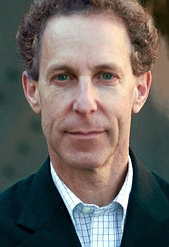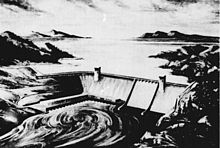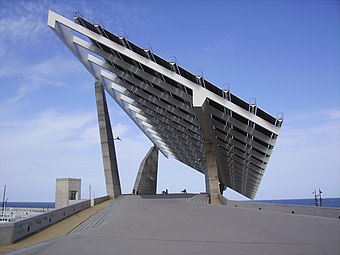Portal:Renewable energy
Introduction Renewable energy (or green energy, low-carbon energy) is energy from renewable natural resources that are replenished on a human timescale. Mainstream renewable energy options include solar energy, wind power, hydropower, bioenergy and geothermal power. Renewable energy installations can be large or small. They are suited for urban as well as rural areas. Renewable energy is often deployed together with further electrification. This has several benefits: electricity can move heat or objects efficiently, and is clean at the point of consumption. Variable renewable energy sources are those that are not dispatchable due to their fluctuating nature, such as wind power and solar power. In contrast, controllable renewable energy sources include dammed hydroelectricity, bioenergy, or geothermal power. Using renewable energy and energy efficiency technologies is resulting in more energy security, climate change mitigation, and economic benefits. From 2011 to 2021, renewable energy grew from 20% to 28% of global electricity supply. Use of fossil energy shrank from 68% to 62%, and nuclear from 12% to 10%. The share of hydropower decreased from 16% to 15% while power from sun and wind increased from 2% to 10%. Biomass and geothermal energy grew from 2% to 3%. Renewable energy systems are rapidly becoming more efficient and cheaper. As a result, their share of the global energy consumption is increasing. A large majority of worldwide newly installed electricity capacity is now renewable. In most countries, photovoltaic solar or onshore wind are the cheapest new-build electricity. Renewable energy can help reduce energy poverty in rural and remote areas of developing countries, where lack of energy access is often hindering economic development. Many countries around the world already have renewable energy contributing more than 20% of their total energy supply. Some countries generate over half their electricity from renewables. A few countries generate all their electricity from renewable energy. National renewable energy markets are projected to continue to grow strongly in the 2020s and beyond. According to the IEA, to achieve net zero emissions by 2050, 90% of global electricity generation will need to be produced from renewable sources. Renewable energy resources exist all over the world. This is in contrast to fossil fuels resources which are concentrated in a limited number of countries. However, the deployment of renewable energy is being hindered by massive fossil fuel subsidies. In 2022 the International Energy Agency requested all countries to reduce their policy, regulatory, permitting and financing obstacles for renewables. This would increase the chances of the world reaching net zero carbon emissions by 2050. There are ongoing debates around the renewable energy topic. For example, whether nuclear power should be grouped under the renewable energy category or not. There are also debates around geopolitics, the metal and mineral extraction needed for solar panels and batteries, possible installations in conservation areas and the need to recycle solar panels. Although most renewable energy sources are sustainable, some are not. For example, some biomass sources are unsustainable at current rates of exploitation. There are also other renewable energy technologies that are still under development, for example enhanced geothermal systems, concentrated solar power, cellulosic ethanol, and marine energy. (Full article...) Selected article -The Rampart Dam or Rampart Canyon Dam was a project proposed in 1954 by the U.S. Army Corps of Engineers to dam the Yukon River in Alaska for hydroelectric power. The project was planned for Rampart Canyon (also known as Rampart Gorge) just 31 miles (50 km) southwest of the village of Rampart, Alaska, about 105 miles (169 km) west-northwest of Fairbanks. The resulting dam would have created a lake roughly the size of Lake Erie, making it the largest human-made reservoir in the world. The plan for the dam itself called for a concrete structure 530 feet (162 m) high with a top length of about 4,700 feet (1,430 m). The proposed power facilities would have consistently generated between 3.5 and 5.0gigawatts of electricity, based on the flow of the river as it differs between winter and summer. Though supported by many politicians and businesses in Alaska, the project was canceled after objections were raised. Native Alaskans in the area protested the threatened loss of nine villages that would be flooded by the dam. Conservation groups abhorred the threatened flooding of the Yukon Flats, a large area of wetlands that provides a critical breeding ground for millions of waterfowl. Fiscal conservatives opposed the dam on the grounds of its large cost and limited benefit to Americans outside Alaska. (Full article...)Quotations -
Main topicsRenewable energy sourcesGeneralRenewable energy commercialization · Smart grid · Timeline of sustainable energy research 2020–present Renewable energy by countryList of countries by electricity production from renewable sources
WikiProjectsWikiProjects connected with renewable energy:
Selected image -Selected biography - Dan William Reicher is an American lawyer who was U.S. Assistant Secretary of Energy for Energy Efficiency and Renewable Energy at the U.S. Department of Energy (DOE) in the Clinton Administration. Reicher is currently executive director of the Steyer-Taylor Center for Energy Policy and Finance at Stanford University, a joint center of the Stanford Graduate School of Business and Stanford Law School, where he also holds faculty positions. Reicher joined Stanford in 2011 from Google, where he served since 2007 as Director of Climate Change and Energy Initiatives for the company's venture Google.org. Reicher also served as an advisor to the 2008 Obama campaign and a member of the Obama Transition Team where he focused on the energy portions of the Obama stimulus package. (Full article...)Did you know? -... that The Clean Tech Revolution: The Next Big Growth and Investment Opportunity, the 2007 book by Ron Pernick and Clint Wilder, argues that commercializing clean technologies is a profitable enterprise that is moving steadily into mainstream business ? As the world economy faces challenges from energy price spikes, resource shortages, global environmental problems, and security threats, clean technologies are seen to be the next engine of economic growth. Pernick and Wilder highlight eight major clean technology sectors: solar power, wind power, biofuels, green buildings, personal transportation, the smart grid, mobile applications (such as portable fuel cells), and water filtration. Very large corporations such as GE, Toyota and Sharp, and investment firms such as Goldman Sachs are making multi-billion dollar investments in clean technology. General images -The following are images from various renewable energy-related articles on Wikipedia.
Related portalsCategoriesAssociated WikimediaThe following Wikimedia Foundation sister projects provide more on this subject:
Discover Wikipedia using portals
|
This page was last updated at 2024-05-03 10:56 UTC. Update now. View original page.
All our content comes from Wikipedia and under the Creative Commons Attribution-ShareAlike License.
























































![Image 56Concentrated solar panels are getting a power boost. Pacific Northwest National Laboratory (PNNL) will be testing a new concentrated solar power system – one that can help natural gas power plants reduce their fuel usage by up to 20 percent.[needs update] (from Solar energy)](https://upload.wikimedia.org/wikipedia/commons/thumb/8/82/Photo_of_the_Week-_Boosting_Solar_Technology_%288722948189%29.jpg/120px-Photo_of_the_Week-_Boosting_Solar_Technology_%288722948189%29.jpg)
























